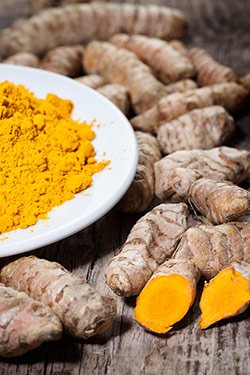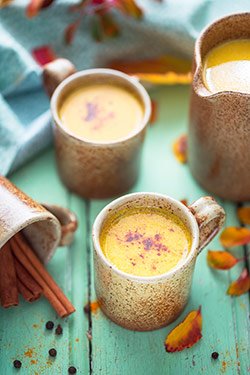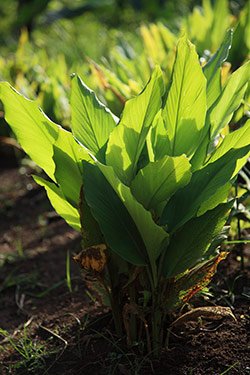A frequently overlooked way to enhance and optimize health with organically grown food is to use herbs and spices – unprocessed and organic, of course.
Turmeric root powder has been used for thousands of years for both culinary and health purposes
One profound benefit of these herbs lies in their nutritional content. They’re very low in calories, while being dense in vitamins and minerals.
Many herbs and spices are thermogenic, meaning they naturally support your metabolism to help you burn calories. Plus you feel satisfied sooner, so you eat less.
Studies show that consuming certain herbs and spices before each meal can potentially reduce your caloric intake.
For best results, I recommend combining this with diet and exercise for a well-rounded strategy.
Herbs and spices can powerfully support your health, courtesy of their high levels of antioxidants. Some contain even greater mounts than many fruits and vegetables!
What’s more, these antioxidants target your entire body, not just one or two parts. This "whole person" approach is why I believe certain spices and herbs can be so potentially beneficial.
One particular spice, in my opinion, is the “granddaddy” of them all because its benefits are so exceptional and far-reaching.
From a Valued Part of India’s Ayurvedic Practice to Culinary Must-Have, Turmeric Shines
Turmeric Latte, a recipe in my
Fat for Fuel Ketogenic Cookbook is a deliciously warming dairy-free beverage
People in India and China have used turmeric for thousands of years. Turmeric continues to be a highly regarded herb in India’s Ayurveda system, recognized as an authoritative source of knowledge and truth in the promotion of natural health.
Today, turmeric is also considered an adaptogen – or botanical that supports your body’s ability to adapt to stress from any source. Adaptogens are valued for their contribution to energy, stamina, endurance, strength, and mental clarity.*
On a cellular level, turmeric can assist your cells by helping to neutralize substances that can cause stress and maintaining the cells' integrity when threatened by these stressors.*
In addition to its potential health benefits, turmeric’s aromatic, pungent flavor adds a delicious flavor boost to cuisine. The vibrant yellow hue in curry and other dishes comes from turmeric.
Since turmeric is so renowned for both culinary uses and for health, I like to include it in food preparation as much as possible.
You’ll find turmeric in several recipes in Pete Evan’s and my cookbook, Fat for Fuel Ketogenic Cookbook, including hearty Beef Bone Broth with Turmeric, Coconut Cream, and Ginger, as well as Turmeric Latte, a warming beverage enjoyed all around the world.
The Connection Between Turmeric and Curcumin, and Why They Deserve a Closer Look
Turmeric is a member of the ginger root family
The most active ingredient in turmeric is curcumin, which is what also gives turmeric its yellow color. Turmeric is derived from the rhizomes, or underground stems, of the plant Curcuma longa, a member of the ginger family.
Sometimes in the literature and on the internet turmeric and curcumin are used interchangeably, but they are not the same. Curcumin only makes up between 2 and 6 percent of turmeric.
Both curcumin and turmeric have potential advantages for health.
Some prefer turmeric because it’s a whole food. Others enjoy curcumin for its concentrated effects. I believe each has its own worthy attributes.
Here’s the major difference between the two...
Whole food turmeric contains all the naturally occurring bioflavonoids, whereas curcumin is typically an extract of the key curcuminoids.
One major difference between the two is whole food turmeric contains all the naturally occurring bioflavonoids, whereas some curcumin products like my Curcumin Advanced is a standardized extract of bioavailable key curcuminoids.
None the less, turmeric has been on the “top 10 superfoods” list in Chinese medicine for many years. Here are just some of the research-suggested uses for turmeric:
- Normal inflammatory response in your body and brain*
- Digestive health, especially the digestion of fats*
- Mood and mental health*
- Cognitive health*
- Heart health*
- Joint health, flexibility and comfort*
- Normal healthy immune response*
- Cellular health*
- Colon and gut health*
- Skin health*
- Prostate and breast health
Turmeric’s Influence on Your Inflammatory Response and Signs of Aging May Be Its Greatest Potential Attributes*
Essential for health, antioxidants are your body’s number one way to neutralize free radicals and help you slow down the signs of normal aging.*
Turmeric may help give your skin a healthy glow
Reactive oxygen species (ROS) and free radicals can damage your mitochondria, cells, and organs – and speed up your aging process – something I’m sure you’d much rather put the brakes on!
Antioxidants, like turmeric, play an important role in helping to tame those free radicals.
The antioxidants in turmeric are in the form of active compounds called curcuminoids, whose activity may be:
- Three times more powerful than grape seed or pine bark extract
- Powerful enough to scavenge the hydroxyl radical – considered by many to be the most reactive of all oxidants*
- Helpful in protecting your cells’ mitochondria and genetic material*
Some of the first signs of aging as you grow older are changes to your skin.
Curcuminoids support healthy joints and important blood and liver functions, which in turn help promote radiant, supple skin.*
In fact, turmeric has been regarded as “skin food” for thousands of years in India and other cultures.*
Providing basic nourishment to your skin cells and promoting a normal healthy inflammatory response, this valuable antioxidant may act as your one-two punch against the early signs of cellular aging.*Comment by CHRISTINA on January 2, 2018 at 6:44am
Comment by Besimi on January 1, 2018 at 11:14pm





![]()





You need to be a member of Saviors Of Earth to add comments!
Join Saviors Of Earth